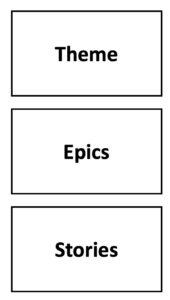There seems to be some confusion in the Agile world about the difference between Epics and Themes. At the Agile101 blog, Tara Hamilton-Whitaker, a certified scrum master, admits “People often (myself included!) get confused about the difference between Agile Themes, Epics and User Stories.” She then goes on to define them, and a healthy discussion ensues, with someone pointing out that she’s exactly reversed the definitions of Epics and Themes as defined by others. I was asked about the difference last week, epic vs theme, and my answer wasn’t crisp.
Epic
An Epic is a large story that cannot be completed in a single sprint. For example, you may set yourself a goal of creating the ultimate guide to your product category, and as you outline this guide, you realize that it cannot possibly be accomplished in a 2-week Sprint.
Time is the distinguishing characteristic of Epics. If you write a user story that has a singular goal, and that goal takes an extended time to realize, longer than a single Sprint, then the user story is an Epic.
Theme
A Theme is a group of user stories that share a common attribute, and for convenience they are grouped together. The individual user stories, however, can each be accomplished in a single sprint. For example, you might have three different user stories that are all communication (PR) related around a new product. They share a common message, and can be grouped together as a Theme. Each of the user stories has a different end goal and acceptance criteria, maybe a different channel of communication. They may have different audiences. They could not be written as a single user story. They are not an Epic.
A particular user story can belong to more than one theme, but not to multiple epics. For example, if you’re creating a piece of content and also doing some PR around that content, it could easily belong to the same theme, but not the same Epic.
Where Is the Confusion?
If that seems fairly straightforward, you may wonder where the confusion lies. Confusion arises for one of two reasons: first, in the mistaken attempt to create a hierarchy of Themes, Epics and User Stories and second, in the belief that some items can be either an Epic or a Theme. Let’s look at each of these in turn.
Is There a Hierarchy?
Again, at the Agile101 blog, Tara Hamilton-Whitaker draws the following hierarchy to illustrate the difference between Epics and Themes:

I think this is a mistake. If you are trying to accomplish something like “improve login page usability”, break it down into multiple user stories, each of which has its own acceptance criteria.
“Improve login page usability” becomes a theme, not an Epic, because it’s not a user story with a single goal and acceptance criteria.
I reserve the term Epic for those user stories which cannot be broken down any further, but simply take time to realize, more time than we have in a single sprint. User stories and Epics are on the same level of the hierarchy because they are the same thing – both are user stories. Epics simply take more time. And a theme is not so much a higher level on the hierarchy, as it is a rubber band around a set of user stories to group them for your convenience.
There is also a tendency to say that some items could be either a theme or a user story. For example, let’s say you’re trying to address the Buyer’s Journey. You could write a single user story: “As a buyer of agile project management tools, I want to find appropriate content on your web site for each stage in my buyer’s journey so that at each stage I can make the most informed decision possible for my company”.
This story could take several sprints to accomplish, and be classified as an Epic.
I’d recommend a different approach. Break this goal into smaller user stories, each with their own acceptance criteria. For example, “As a buyer of agile project management tools in the initial investigative stage of the buyer’s journey, I want to determine quickly if your product supports my key criteria so that I can create a short list of products to be evaluated.”
If you break the buyer’s journey down in this way, you might then group all of those stories under the theme “buyer’s journey”.
The advantage to this approach is that you’ll create acceptance criteria that are more specific to each stage of the buyer’s journey.
What do you think? Is my approach in sync with how you define epic vs theme? I’d love to hear from you

